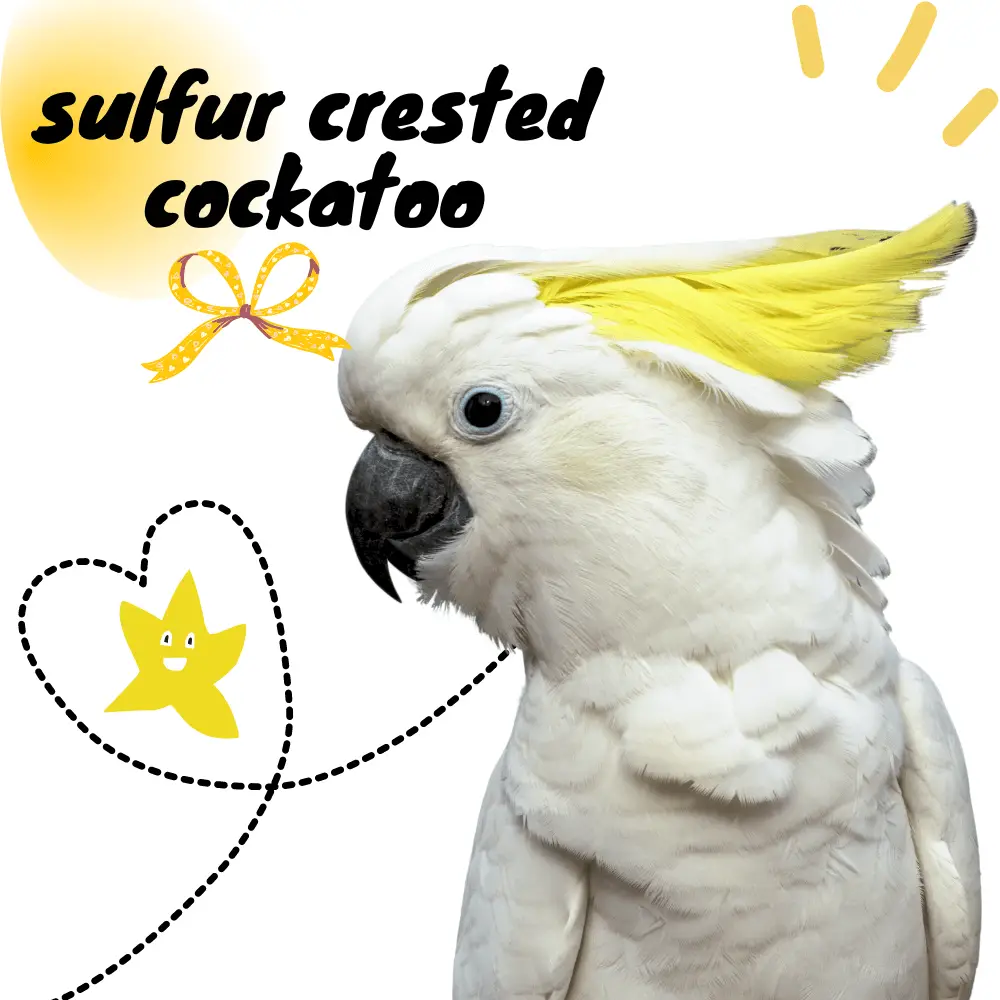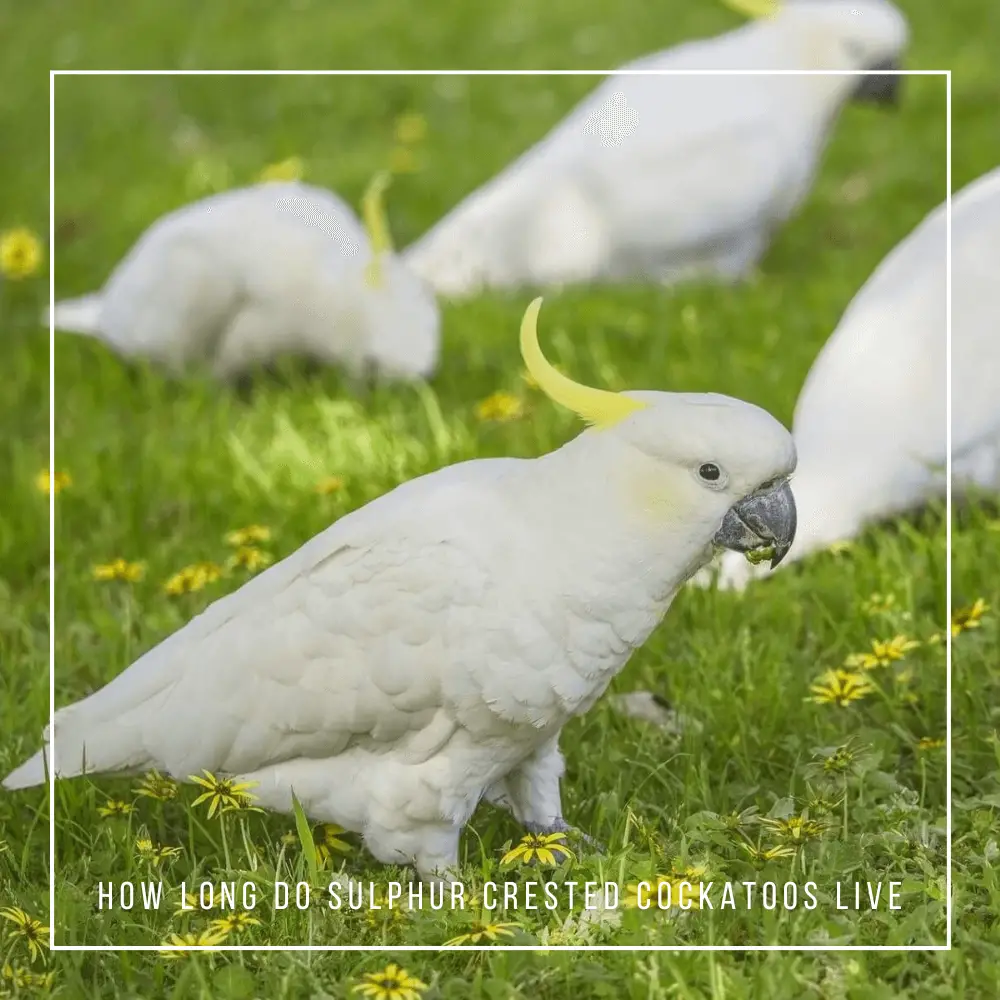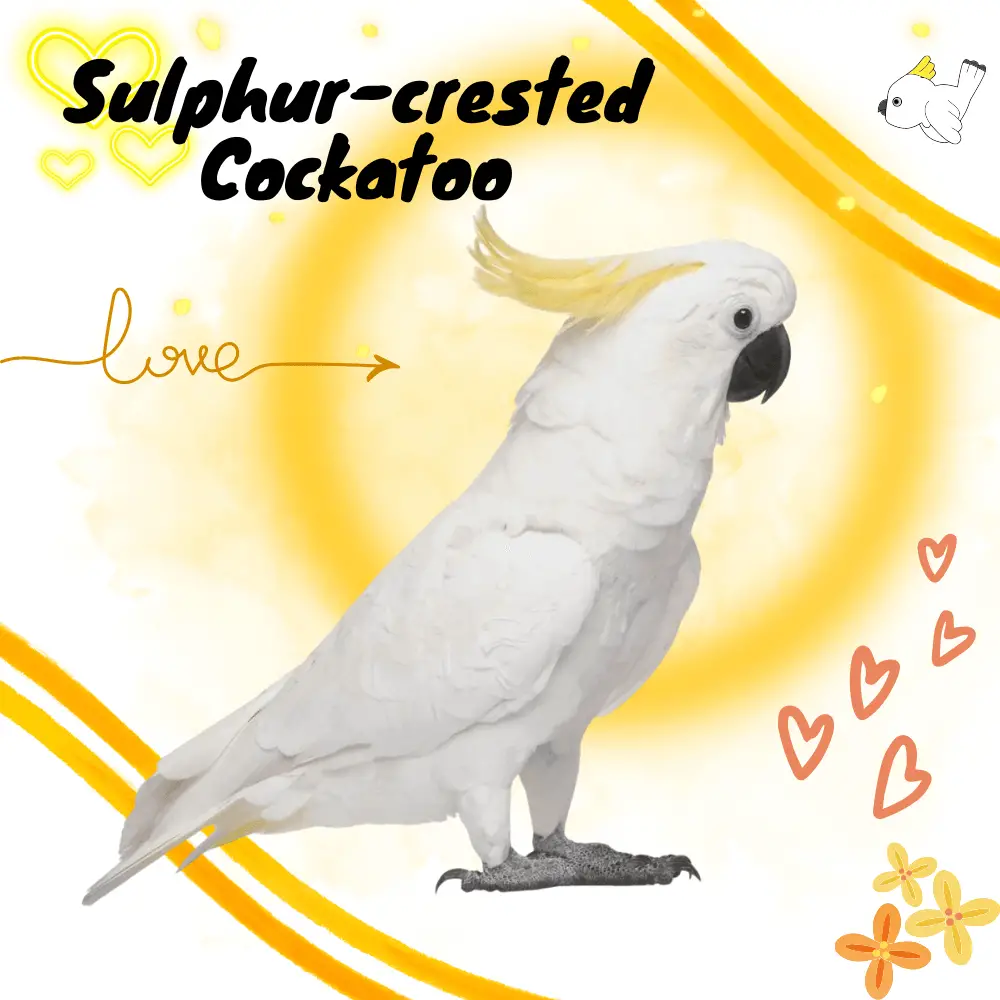The Sulphur-crested Cockatoo is a parrot with white plumage and a yellow erectile crest. It feeds on seeds and fruits. It is a sociable bird, but quite independent. Thus, when he does not want to be disturbed, he can be aggressive, so watch out for pecks! It is an unusual bird, it is difficult to find.
Big and proud, the yellow-crested cockatoo is easily identified by its characteristic yellow crest. Its large wings allow it to fly easily, while its stocky body and long tail give it great stability in the air. The bird’s head protrudes from its body with a single forehead, topped with gray talons.
- Eyes: dark, surrounded by a bluish zone
- Beak: very dark grey, almost black.
- Legs: gray.
- Color (s): the dress is uniformly white.
- Wingspan: 103.
- Plumage: bright white, with a bright yellow crest. The undersides of the wings and tail shine with a light yellow tint.
- Sexual Dimorphism: Although males and females may look similar, they have distinct physical differences: the female is smaller than the male and their eye color is not identical. Females usually have reddish-brown eyes while males are mostly black.
- CUT: 54 to 57cm
- WEIGHT: 78 to 80 g
- BAND: Parrots
- LIFESPAN: 70 to 80 years old
- Sulphur-crested Cockatoo price: 1700 to 2300$
Sulphur crested cockatoo information
The natives captured it very early to tame it. In Europe, its first appearance dates from the 13th century. There are four illustrations of cockatoos in a manuscript written by Emperor Frederick II who reigned over the Holy Empire from 1215 to 1250.
He was king of the Romans, king of Sicily, king of Provence-Burgundy, and king of Jerusalem. Best known for his passion for animals and hunting, he is the author of a monumental treatise on falconry in Latin published under the title De arte venandi cum Avibus, “On the art of hunting by means of birds”.
The manuscript decorated with illuminations featuring the cockatoos is now kept in the Vatican Library. Their crest is not erect, which proves that the bird which served as a model was accustomed to the king’s court and was perfectly tamed.
It was discovered recently in the writings of the emperor that a cockatoo was given to him by the Sultan of Cairo to enrich his collection of exotic parrot species. The bird is said to have transited from the East through the Middle East to the West.
Sulphur crested cockatoo as pets
SOURCE: African Grey Parrot Pet
Sulfur crested cockatoo behavior

The Sulphur-crested Cockatoo is gentle, intelligent, and very clean. It is easily tamed, but it requires a lot of attention. He has an exclusive and jealous character. In the family which adopts him, if he prefers the woman, he can manifest a certain aggressiveness against the husband. But a well-behaved parrot brings joy, with the care that captive-bred birds require.
In the wild, its flight is rapid with sharp wing beats. It likes to glide through the air in wide circles before landing on the ground. Every evening, the cockatoos congregate in wooded areas and near waterways. They live in an organized world with sentries tasked with spotting predators.
Like most parrots, the cockatoo needs water to drink, but also to bathe. He likes to stay in heavy rain. The cockatoo feeds on seeds and roots. It utters high-pitched calls, with a hoarse “ah-yai-yah” or “kai-yah”. The final intonation is rising or falling, depending on the case.
Sulphur-crested Cockatoo habitat
The Sulphur-crested Cockatoo frequents Australia, New Guinea and surrounding islands. It is found everywhere up to thousand five hundred meters of altitude. He lives in forests and wooded areas.
Sulphur crested cockatoo breeding season
The Sulphur-crested Cockatoo is monogamous. During courtship, he performs elaborate dance steps in front of his partner in order to dazzle her. He has a vast repertoire of these steps, improvising as he goes. He is a fan of choreography and he is a master in this art.
The female lays her eggs in the hole of a tree or on piles of pieces of wood. The brooding is done in pairs, in turn for thirty days, and the parents feed the chicks for three months, then take care of them for another year.
Reproduction in captivity: among the White Cockatoos, it is one of the most difficult to reproduce in captivity: we are obliged to provide it with spacious aviaries, because of its large size, and quietness.
Sulphur crested cockatoo breeders
SOURCE: African Grey Parrot Pet
Sulphur-crested Cockatoo diet
Yellow-crested cockatoos have a varied diet, ranging from roots and rhizomes to nuts, berries like hawthorns, flowers, and even bulbs or insect larvae. They use their paws to hold food before crushing it with their powerful beaks.
For food, these birds consume a variety of fruits, nuts, and roots. They also have an interesting social system in place when feeding: a member is responsible for keeping watch from the top of a tree!
Sulphur-crested Cockatoo lifespan
The Sulphur-crested Cockatoo’s life expectancy is 70 to 80+ years, giving a lifespan of around 75 years.

Are sulphur crested cockatoos endangered
The Sulphur-crested Cockatoo is still hunted in New Guinea today for crest feathers. It is considered a nuisance in urban areas. Indeed, due to the destruction of its habitat, the bird has moved to urban areas. He nibbles on the wooden balconies, which provokes the anger of the townspeople, he opens the garbage cans, and nothing can resist him. He adapted his behavior to urban life.
The sulphur-crested cockatoo poses a significant threat to agricultural areas. It wreaks havoc by entering newly planted land and consuming ripening ears, damaging crops.
On the other hand, the export is controlled and the species, although it is in decline, is not yet threatened.
The most formidable predators of the yellow crested cockatoo are the Powerful Booby and the monitor lizards. Her chicks and eggs, however, remain vulnerable to a range of scavengers, including crows and passerines of the genus Cracticus.

